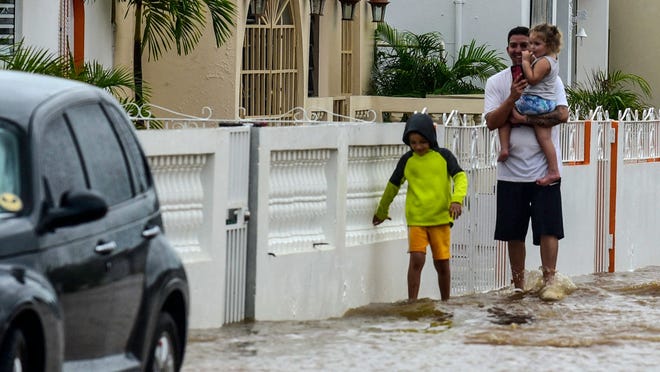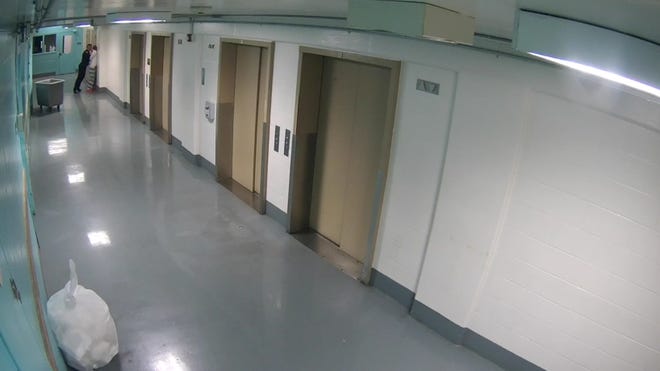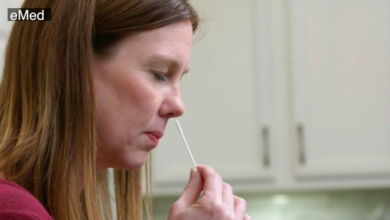
Hurricane Fiona grew more powerful Tuesday as it rolled past Puerto Rico and the Dominican Republic after pounding them with up to 30 inches of rain, triggering overwhelming flooding, mudslides and destruction.
The storm reached the Turks and Caicos Islands as a Category 3 hurricane, blasting the British territory of about 40,000 people with maximum sustained winds of 115 mph. The government imposed a curfew and urged people to flee flood-prone areas as the archipelago braced for a storm surge of 5 to 8 feet.
About 80% of Puerto Rico remained without power Tuesday, more than 24 hours after the storm shut down the island's entire electrical system. Water service was cut to more than 837,000 customers – two-thirds of the total on the island, officials said.
Gov. Pedro Pierluisi and power distribution company LUMA Energy both said a "big part'' of the island would have electricity back by Wednesday, the newspaper El Nuevo Día reported. Pierluisi allowed for the possibility it might take until the weekend.
The governor also requested a major disaster declaration, which if granted would free up federal funds for public and individual assistance. U.S. Senate Majority Leader Chuck Schumer said he would urge the federal government to cover 100% of disaster response costs as part of that declaration, instead of the usual 75%.
In the Dominican Republic, more than 1 million people were without running water and 700,000 homes and businesses were without power, the national Emergency Operations Center said.
At least three deaths were reported, two in Puerto Rico and one in the Dominican Republic.
IMAGES:Hurricane Fiona floods homes, streets in Puerto Rico
HOW TO HELP:A look at mutual aid, nonprofits to help support Puerto Ricans
Developments:
►More rain was forecast through the week in parts of Puerto Rico, and conditions were not expected to significantly improve. "Catastrophic and life-threatening flash, urban, and moderate to major river flooding, as well as mudslides, are likely for southern and eastern Puerto Rico through Tuesday due the rainfall from Hurricane Fiona," the National Weather Service warned.
►Thousands have been displaced as Puerto Rican authorities said at least 2,300 people and 250 pets were in shelters across the island.
►In Grand Turk, hurricane conditions were slamming the capital of the small British territory of the Turks and Caicos Islands. The government imposed a curfew and urged people to flee flood-prone areas.
►For the U.S. mainland, forecasters say the hurricane is not expected to threaten the United States.
Here's what we know:
Hurricane Fiona strengthens to Category 3 storm
Fiona, which strengthened to a Category 3 storm overnight, is forecast to intensify over the next couple of days, the National Weather Service said:
- Centered near Grand Turk Island: Fiona, with sustained winds of 115 mph, was moving north-northwest at 9 mph and was centered about 40 miles north of Grand Turk Island.
- Turks and Caicos: Hurricane conditions over the Turks and Caicos were expected to persist for hours. Heavy rains were forecast to continue through this afternoon and cause life-threatening flooding, the National Weather Service said.
- In the Bahamas: Tropical storm conditions were expected to spread over portions of the southeastern Bahamas through the day.
Early toll in Dominican Republic: 1 dead, 12,000 displaced
More than 1,000 residents of the Dominican Republic were living in shelters Tuesday after Fiona tore through the country. More than 1 million of the nation's almost 12 million people were without running water, and more than 700,000 homes and businesses were without power, the national Emergency Operations Center said.
One death was reported, 12,485 people were displaced, 3,000 homes were damaged or destroyed, and four bridges collapsed.
Juan Manuel Mendez, director of the organization, told Dominican Today that Isidro Odalis Smith, 68, was crushed by a falling tree in the northern town of Nagua in Maria Trinidad Sanchez province.
President Luis Abinader pledged to restore drinking water and electrical service to communities "as soon as possible." He said authorities would need several days to assess the damage.
Officials closed ports and beaches and told most people to stay home from work. The hurricane left several highways blocked, and a tourist pier in the town of Miches was severely damaged by high waves. At least four international airports were closed, officials said.
How you can help
Advocates stresses the importance of supporting local organizations and grassroots mutual aid groups providing on-the-ground relief to communities in Puerto Rico. Multiple organizations are providing crucial aid such as solar lights, generators, supplies and food.
To help Puerto Ricans and others in the Caribbean recover, here's a list of some nonprofits and mutual aid funds you can support.
More rain for overwhelmed Puerto Rico
The National Weather Service warned of another 1 to 4 inches of rain for much of Puerto Rico into Wednesday morning. Storm totals have reached 12 to 20 inches in most areas, but some locations have seen up to 35 inches.
"Localized additional flash and urban flooding is possible in southern portions of Puerto Rico," the weather service said.
National Guard Brig. Gen. Narciso Cruz put the flooding in perspective by comparing it to the massive amount of water Category 4 Hurricane Maria brought five years ago Tuesday.
“There were communities that flooded in the storm that didn’t flood under Maria,” Cruz said. “I’ve never seen anything like this.”
Fiona made landfall as a Category 1 storm Sunday afternoon on the southwestern coast of Puerto Rico, then made landfall again early Monday on the Dominican Republic's east coast.
2,500 affected in coastal Salinas
In hard-hit Salinas, a municipality of about 30,000 people on the southern coast of Puerto Rico, Mayor Karilyn Bonilla estimated 2,500 people had their homes swamped. The National Guard led a team of responders in more than 500 water rescues, and Bonilla expressed gratitude for lifesaving efforts "that put their own at risk."
“We had to do a titanic operation to rescue people who were in areas completely flooded," Bonilla said. "Refugees tell us that they have been living in some communities for 60 years and an event of this magnitude had never happened."
Minerva Monge, 70, was rescued with her husband by the National Guard after water in their home reached their knees.
"What I hope is that everything calms down, the place dries up and we can return," she said.
Biden promises more federal aid
AccuWeather estimated the economic impact on the island from Fiona at about $10 billion. President Joe Biden, who has declared a state of emergency to release federal aid, said he spoke with Gov. Pedro Pierluisi late Monday. Biden promised to increase support "substantially" in the coming days.
"Jill and I are keeping the people of Puerto Rico in our prayers as Hurricane Fiona passes over your beautiful island," Biden tweeted. "We are here for you, and we will get through this together."
Puerto Rico is still recovering from Hurricane Maria 5 years ago
Fiona struck Puerto Rico almost five years to the day after Hurricane Maria slammed the island on Sept. 20, 2017, with wind speeds of up to 155 mph – just 2 mph short of a Category 5 storm.
Maria caused nearly 3,000 deaths, destroyed the power grid and devastated tens of thousands of homes – about 3,000 of which remain covered by tarps.
Bridge built after Maria swept away by Fiona
The destruction wrought across the island by Fiona included a temporary bridge in the city of Utuado that was built after Hurricane Maria. The bridge over the Guanica River in the central mountain region was swept away by floodwaters Sunday when Fiona made landfall.
U.S. House Delegate Roberto Lefranc Fortuño posted video of the bridge, known as PR-123, tearing apart and washing away. People can be heard screaming amid the clattering of metal as a man stands with his hands on his head in disbelief.
IN MEXICO:Major earthquake strikes on Sept. 19 for third time since 1985
Contributing: The Associated Press









